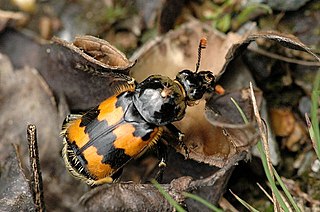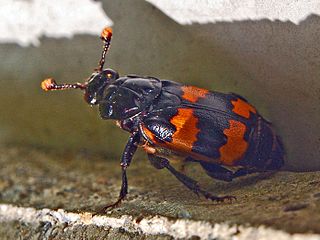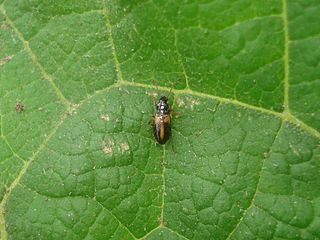
Silphidae is a family of beetles that are known commonly as large carrion beetles, carrion beetles or burying beetles. There are two subfamilies: Silphinae and Nicrophorinae. Nicrophorines are sometimes known as sexton beetles. The number of species is relatively small and around two hundred. They are more diverse in the temperate region although a few tropical endemics are known. Both subfamilies feed on decaying organic matter such as dead animals. The subfamilies differ in which uses parental care and which types of carcasses they prefer. Silphidae are considered to be of importance to forensic entomologists because when they are found on a decaying body they are used to help estimate a post-mortem interval.

Staphylinoidea is a superfamily of beetles. It is a very large and diverse group with worldwide distribution.

Dermestes is a genus of beetles in the family Dermestidae, the skin beetles. The genus is distributed worldwide.

Silpha is a genus of the family Silphidae, or carrion beetles, native to the Old World, with one species that is adventive in Canada.

Denticollinae is a subfamily of beetle in the click beetle family. They occur in most regions of the world but are more abundant in cool temperate areas.

Nicrophorus interruptus is a species of burying beetle or sexton beetle belonging to the family Silphidae subfamily Nicrophorinae.

Xyletinus is a genus of death-watch and spider beetles in the family Ptinidae and subfamily Xyletininae.

Onthophagus is a genus of dung beetles in the Onthophagini tribe of the wider scarab beetle family, Scarabaeidae. It is the most species-rich and widespread genus in the subfamily Scarabaeinae, with a global distribution.

Cymindis is a genus of ground beetle native to the Palearctic, the Near East, and North Africa. It contains the following species:

Acupalpus is a genus of insect-eating beetle species. Its representatives are found across Europe, Asia, and North America.
Phaenops is a genus of beetles in the family Buprestidae, containing the following species:
Mnuphorus is a genus of beetles in the family Carabidae, containing the following species:

Silphinae is a subfamily of burying beetles or carrion beetles. There are 113 extant species of this subfamily, in two tribus and in 14 genera.

Eodorcadion is a genus of longhorn beetles of the subfamily Lamiinae, containing the following species:

Ablattaria is a genus of burying beetles or carrion beetles belonging to the family Silphidae.

Macrosiagon is a genus of wedge-shaped beetles in the family Ripiphoridae. There are more than 20 described species in Macrosiagon.
Trichalophus is a genus of broad-nosed weevils in the beetle family Curculionidae. There are more than 50 described species in Trichalophus.

Aclypea opaca is a species of carrion beetle in the family Silphidae. It is found in Europe & Northern Asia and North America.
Aclypea bituberosa, the western spinach carrion beetle, is a species of carrion beetle in the family Silphidae. It is found in North America.
Ipelates is a genus of primitive carrion beetles in the family Agyrtidae. There are at least four described species in Ipelates.
















